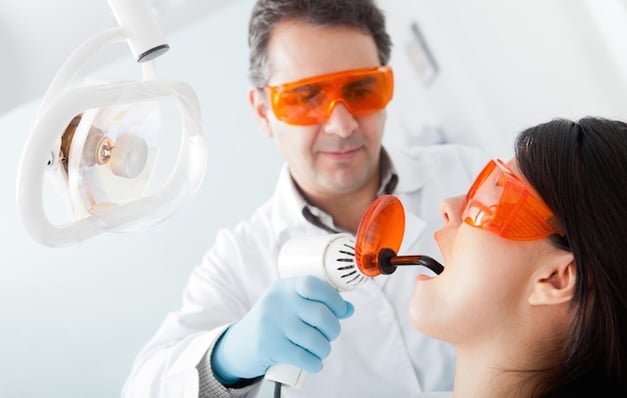
While 99 percent of what it takes to maintain excellent oral health comes down to a few simple habits, it’s important to realize that urgent or emergency situations can arise at any moment, threatening your oral health and potentially leading to other negative consequences.
None of us look forward to being involved in a medical emergency, but being adequately prepared can determine how extensive the damage will be, so let’s cover the three most common emergency dental care situations and how you can be prepared to handle them. If you think you’re already prepared, take our Pop Quiz to make sure!
A tooth is knocked out
Obviously, this emergency situation arises due to some sort of accidental trauma: a collision on the sports field, a car accident, or a slip-and-fall incident. Simple clumsiness may be involved, but more often it comes down to failing to take necessary precautions, including wearing appropriate safety gear in dangerous situations.
If you find yourself staring down at the tooth in your hand, time is of the essence. Take these important steps to preserve the tooth in hopes of replacing it:
- If you’re able to locate the tooth, pick it up by the crown, not the root. (This is important to prevent infection as it keeps the root as clean as possible and hopefully free of germs.)
- Keep the tooth as clean and intact as possible. If you’re able to place it back in its socket, that’s the best choice. Hold it there with a clean towel or gauze. If you can’t, put it in a sealed container filled with a saline solution to keep it moist.
- Find a dentist immediately.
When one (or more) of your teeth has been forcibly removed, your priority needs to be keeping it clean and moist until a dental professional can put it back in and repair the damage to the gum so it heals properly. If the tooth dries out or gets contaminated, the dentist may not be able to replace it.
A chipped or cracked tooth
"While 99 percent of what it takes to maintain excellent oral health comes down to a few simple habits, it’s important to realize that urgent or emergency situations can arise at any moment, threatening your oral health and potentially leading to other negative consequences."
While a very small chip coming off a tooth many not be considered an emergency situation, it’s a good idea to make an appointment to see your dentist soon so they can inspect it and suggest treatment or repair as needed. In these cases, over-the-counter pain relievers are usually sufficient, combined with avoiding actions that trigger pain, like chewing with the injured tooth or consuming very hot or cold foods and drinks.
However, a serious tooth fracture (cracked or broken tooth,) can be incredibly painful and it needs immediate attention. If your tooth breaks, follow these steps to control the pain and give your dentist the best chance of repairing the damage:
- Rinse your mouth with warm water. (Swish gently and replace the water often.)
- If you’re bleeding, apply gentle pressure with clean gauze until it stops. (Some people find that a warm tea bag is both effective and comforting for this purpose.)
- If there is resulting swelling, apply a cold pack to the skin outside of the broken tooth.
- Take over-the-counter (OTC) pain relievers to help control pain.
- Get to a dentist immediately.
Whether the breakage was caused by trauma or a cavity, your dentist will be able to determine if the nerve or blood vessels are damaged, and how to save as much of the natural tooth as possible.
Chronic tooth pain
Although most people associate the term “toothache” with a minor nuisance, serious chronic tooth pain can quickly go from mildly annoying to all-consuming, even affecting your quality of life.
Tooth pain can occur for many reasons: tiny fractures in the tooth that you can’t even see, a foreign object stuck in the gum line, cavities or advanced tooth decay, and more. Whatever the cause, the steps needed to treat a toothache remain the same:
- Rinse with warm salt water. (This helps soothe an aching tooth and also has antibacterial qualities).
- Gently floss around the tooth. (Sometimes, a small bit of food or other object has become lodged between two teeth or between the tooth and the gum, causing constant pressure or swelling, both of which are painful.)
- Take a recommended, appropriate dose of an over-the-counter pain reliever.
- Apply an ice pack to the outside of the mouth where the aching tooth is. (To reduce swelling and related pain.)
If any of these steps provides instant relief and/or you discover exactly what was causing your pain, it may be tempting not to worry about consulting a dentist. However, the safe option is to let your dentist examine you as soon as possible so they can determine an initial cause and if it’s likely to result in any long-term consequences. Of course, if you still don’t know what’s causing the toothache, or you’re getting no relief, see your dentist as soon as possible.
Although we don’t like to think about dealing with dental emergencies, it’s always best to be prepared to handle the situation calmly and quickly.
Involve your dentist as soon as possible any time you experience a dental emergency. If cost is a concern, a discount dental card can make your urgent oral health needs more affordable no matter what unexpected situations come up.

